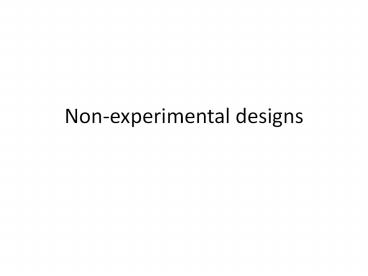Non-experimental designs - PowerPoint PPT Presentation
Title:
Non-experimental designs
Description:
Experimenters exert control through manipulation and assignment ... Stockholm syndrome. Observational Research. Four approaches to observation: ... – PowerPoint PPT presentation
Number of Views:158
Avg rating:3.0/5.0
Title: Non-experimental designs
1
Non-experimental designs
2
Outline
- Experimental vs. non-experimental research
- Four kinds of non-experimental research
- Observational research
- Archival research
- Case studies
- Surveys
3
1. Experimental vs. non-experimental research
- Experimental research requires exerting control.
- Experimenters exert control through manipulation
and assignment
4
1. Experimental vs. non-experimental research
- Manipulation
- researcher systematically varies conditions
under which participants perform task - treatments
5
1. Experimental vs. non-experimental research
- Manipulation
- Assignment
- researcher decides who gets which treatment
6
1. Experimental and non-experimental research
compared
- Non-experimental research allows researcher much
less control
- No assignment
- In many cases, no manipulation
7
1. Experimental and non-experimental research
compared
- Four approaches
- Observational
- Recording ongoing behavior without trying to
influence it.
8
1. Experimental and non-experimental research
compared
- Four approaches
- Observational
- Archival
- Testing a hypothesis using data that the
researcher did not collect
9
1. Experimental and non-experimental research
compared
- Four approaches
- Observational
- Archival
- Case study
- Researcher carries out very detailed examination
of individual cases
10
Experimental and non-experimental research
compared
- Four approaches
- Observational
- Archival
- Case study
- Survey
- Researcher collects information on beliefs,
attitudes, preferences, behaviors, and their
correlations.
11
Observational Research
- The researcher observes behavior without
influencing it. - Goals
- to describe behavior as it naturally occurs
12
Observational Research
- The researcher observes behavior without
influencing it. - Goals
- to describe behavior as it naturally occurs
- to assess relationships among variables present
13
Observational Research
- Four approaches to non-experimental research
- Observational
- Archival
- Case study
- Survey
- Four approaches to observation
- Naturalistic observation
- Participant-observer research
- Structured observation
- Field experiments
14
Observational
Archival
Case Study
Survey
Naturalistic
Participant- observer
Structured observation
Field experiments
15
Naturalistic Observation
- Observing phenomena that cannot be created in
lab, for practical or ethical reasons
- Effects can be observed when such events occur
naturally
16
Naturalistic Observation
- Physical trace measures
- e.g., how well-thumbed is a book?
- Where do paths through the snow go?
- Reactivity
- subjects react to the presence of the observer
17
Naturalistic Observation
- Example effect of early childhood isolation on
later psychological development.
- We cant isolate children to study them
- But we can use naturalistic observation when we
discover such cases
18
Naturalistic observation
- Candland (1993) descriptions of feral children
(raised outside human cultures) - Curtiss (1977) case studies of children
subjected to unusual isolation by parents (e.g.,
Genie)
- Spitz (1965) observation of institutionalized
children - Showed effects of deprivation of stimulation
during infancy and early childhood
19
Observational Research
- Four approaches to observation
- Naturalistic observation
- Participant-observer research
- Structured observation
- Field experiments
20
Participant-observer research
- Observer joins a group for the purpose of
studying group members
- Undisguised vs. disguised
- Why use disguised observation?
- Access to behavior and situations
21
Participant-observer research
- Observer joins a group for the purpose of
studying group members
- Potential cost to objectivity
- Stockholm syndrome
22
Observational Research
- Four approaches to observation
- Naturalistic observation
- Participant-observer research
- Structured observation
- Field experiments
23
Structured observation
- Researcher exerts some control
- Eleanor Gibsons visual cliff studies
- Piagets studies
- Replication depends upon following exactly the
same procedures
24
Observational Research
- Four approaches to observation
- Naturalistic observation
- Participant-observer research
- Structured observation
- Field experiments
25
Field experiments
- Researcher manipulates one or more variables in
a natural setting to determine effect on behavior
- One end of the intervention non-intervention
continuum
26
Field experiments example
- Crusco Wetzel (1984)
- effect of touching on restaurant customers
- waitresses worked as confederates
- tip amount was dependent variable
27
Field experiments example
- Crusco Wetzel (1984)
- Compared No Touch condition with Fleeting Touch
and Shoulder Touch conditions
- Men tipped more than women
- Both men and women tipped more after being
touched at some point during their meal.
28
Observational Research
- Four approaches to non-experimental research
- Observational
- Archival
- Case study
- Survey
- Testing a hypothesis using data that the
researcher did not collect
29
b. Archival Research
- Archival records are a rich source of data
- No possibility of reactivity
- Often very inexpensive approach
- Government files
- Corporations
- Universities
- Newspapers
- Google cache
- Internet wayback machine
30
b. Archival Research an example
- Lau Russell (1980)
- Tested external validity of laboratory findings
on causal attributions
- People make internal attributions for success
and external attributions for failure
31
Lau Russell (1980)
- Sports pages in 8 daily newspapers
- Found 594 explanations for success and failure
involving 33 sports events
- Proportions of internal attributions
- success 75
- failure 45
32
Case Studies
- Intensive studies of individual cases.
- Strength you learn a lot about the case studied
- Weakness results may not generalize
- Well come back to this topic when we look at
Single-Subject Experiments.
33
Surveys - Definition
- A procedure for systematically collecting data
on attitudes, preferences, knowledge, or behavior
by asking people questions.
- The answers provide information about the
group(s) that those people represent.
34
d. Surveys
- Use surveys when
- You want data regarding a large group of people
(a population) - Measuring whole population is too expensive in
time, money or other resources
- Population all the cases of interest
35
Surveys
- Well look at surveys in greater detail in the
next lecture





![Download Book [PDF] Research Designs (Quantitative Applications in the Social Sciences) PowerPoint PPT Presentation](https://s3.amazonaws.com/images.powershow.com/10051233.th0.jpg?_=202406081110)

























